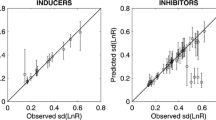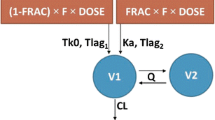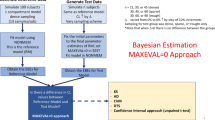Abstract
Population approaches are appealing methods for detecting then assessing drug–drug interactions mainly because they can cope with sparse data and quantify the interindividual pharmacokinetic (PK) and pharmacodynamic (PD) variability. Unfortunately these methods sometime fail to detect interactions expected on biochemical and/or pharmacological basis and the reasons of these false negatives are somewhat unclear. The aim of this paper is firstly to propose a strategy to detect and assess PD drug–drug interactions when performing the analysis with a nonparametric population approach, then to evaluate the influence of some design variates (i.e., number of subjects, individual measurements) and of the PD interindividual variability level on the performances of the suggested strategy. Two interacting drugs A and B are considered, the drug B being supposed to exhibit by itself a pharmacological action of no interest in this work but increasing the A effect. Concentrations of A and B after concomitant administration are simulated as well as the effect under various combinations of design variates and PD variability levels in the context of a controlled trial. Replications of simulated data are then analyzed by the NPML method, the concentration of the drug B being included as a covariate. In a first step, no model relating the latter to each PD parameter is specified and the NPML results are then proceeded graphically, and also by examining the expected reductions of variance and entropy of the estimated PD parameter distribution provided by the covariate. In a further step, a simple second stage model suggested by the graphic approach is introduced, the fixed effect and its associated variance are estimated and a statistical test is then performed to compare this fixed effect to a given value. The performances of our strategy are also compared to those of a non-population-based approach method commonly used for detecting interactions. Our results illustrate the relevance of our strategy in a case where the concentration of one of the two drugs can be included as a covariate and show that an existing interaction can be detected more often than with a usual approach. The prominent role of the interindividual PD variability level and of the two controlled factors is also shown.
Similar content being viewed by others
REFERENCES
W. R. Greco, G. Bravo, and J. C. Parsons. The search for Synergy: A critical review from a response surface perspective. Pharmacol. Rev. 47:331-385 (1995).
M. C. Berenbaum. What is synergy? Pharmacol. Rev. 41:93-138 (1989).
C. C. Peck, R. Temple, and J. M. Collins. Understanding consequences of concurrent therapies. J. Am. Med. Assoc. 269:1550-1552 (1993).
S. A. Wrighton. Utilization of in vitro drug-drug interactions studies in drug discovery development. Pharmacol. Res. 13(Suppl.):S 558 (1996).
D. R. Mungall, T. M. Ludden, J. Marshall, D. W. Hawkins, R. L. Talbert, and M. H. Crawford. Population pharmacokinetics of racemic warfarin in adult patients. J. Pharmacokin. Biopharm. 13:213-227 (1985).
T. M. Ludden. Evaluation of potential drug-drug interactions using the population approach. In L. Aarons, L. P. Balant, M. Danhof, M. Gex Fabry, U. A. Gundert-Remy, M. Karlsson, F. Mentré, P. L. Morselli, F. Rombout, M. Rowland, J. L. Steimer, and S. Vozeh (eds.), The Population Approach: Measuring and Managing Variability in Response Concentration and Dose. Office for Official Publications of the European Communities, Luxembourg, 1997, pp. 41-45.
J. Kuhlmann. Drug interaction studies during drug development: which, when, how? Int. J. Clin. Pharmacol. Ther. 32:305-311 (1994).
H. G. Schaefer, G. Ahr, and J. Kuhlmann. Pharmacokinetic development of quinolone antibiotics. Int. J. Clin. Pharmacol. Ther. 33:266-276 (1995).
T. H. Grasela, E. J. Antal, L. Ereshefsky, B. G. Wells, R. L. Evans, and R. B. Smith. An evaluation of population pharmacokinetics in therapeutic trials. Part II. Detection of drug interaction. Clin. Pharmacol. Ther. 42:433-441 (1987).
M. S. Driscoll, T. M. Ludden, D. T. Casto, and L. C. Littlefield. Evaluation of theophylline pharmacokinetics in a pediatric population using mixed effect models. J. Pharmacokin. Biopharm. 17:141-168 (1989).
W. R. Greco, D. C. Sutor, J. C. Parsons, L. A. Khinkis, L. Hsieh, S. R. Rao, Y. Tung, C. C. Curie, and R. Susice. Monte-Carlo comparison of rival experimental designs for two agent combined action studies. Can. J. Infect. Dis. 5(Suppl.):51-59A (1994).
W. R. Greco and Y. Tung. D-optimal experiment design for quantifying synergy in drug combination study. J. Am. Statist. Assoc. (Proc. Biopharm. Sect.) pp. 244-249 (1991).
M. K. Al-Banna, A. W. Kelman, and B. Whiting. Experimental design and efficient parameter estimation in population pharmacokinetics. J. Pharmacokin. Biopharm. 18:347-359 (1990).
Y. Hashimoto and L. B. Sheiner. Designs for population pharmacodynamics: Value of pharmacokinetic data and population analysis. J. Pharmacokin. Biopharm. 19:333-353 (1991).
E. I. Ette, C. A. Howie, A. W. Kelman, and B. Whiting. Experimental design and efficient parameter estimation in preclinical pharmacokinetic studies. Pharm. Res. 12:729-737 (1995).
F. Mentré, A. Mallet, and D. Baccar. Optimal design in random-effect regression models. Biometrika 84:429-442 (1997).
A. Mallet. Maximum likelihood estimation method for random coefficient regression models. Biometrika 73:645-656 (1986).
A. Mallet, F. Mentré, and J. Gilles. Handling covariates in population pharmacokinetics with application to gentamicin. Biomed. Meas. Inform. Contr. 2:138-146 (1988).
C. E. Shannon. A mathematical theory of communication. Bell System Tech. J. 27:379-423, 623-656 (1948).
F. Mesnil and A. Mallet, Population workgroup: Comparison of population pharmacokinetic modeling methods using simulated data: results from the population modeling work group. Statist. Med. 16:1241-1262 (1997).
S. L. Shafer, J. R. Varvel, N. Aziz, and J. C. Scott. Pharmacokinetics of fentanyl administered by computer-controlled pump. Anesthesiology 73:1091-1102 (1990).
S. L. Shafer. Advances in propofol pharmacokinetics and pharmacodynamics. J. Clin. Anesth. 5:14S-21S (1993).
W. E. Haeffely, J. R. Martin, J. Grayson Richards, and P. Schoch. The multiplicity of actions of benzodiazepine receptor ligands. Can. J. Psychiat. 38:102-108 (1993).
R. Laplanche, B. Fertil, E. Nuech, J. P. Jais, W. Niederberger, and J. L. Steimer. Exploratory analysis of population pharmacokinetic data from clinical trials. Clin. Pharmacol. Ther. 50:39-54 (1991).
P. O. Maitre, M. Buret, and D. R. Stanski. A three-step approach combining Bayesian regression and NONMEM population analysis: Application to midazolam. J. Pharmacokin. Biopharm. 19:377-384 (1991).
J. W. Mandema, D. Verotta, and L. B. Sheiner. Building population pharmacokinetic/pharmacodynamic models. I. Models for covariate effects. J. Pharmacokin. Biopharm. 20:511-528 (1992).
D. Verotta. Building population pharmacokinetic-pharmacodynamic models using trees. In L. Aarons, L. P. Balant, M. Danhof, M. Gex Fabry, U. A. Gundert-Remy, M. Karlsson, F. Mentré, P. L. Morselli, F. Rombout, M. Rowland, J. L. Steimer, and S. Vozeh (eds.), The Population Approach: Measuring and Managing Variability in Response Concentration and Dose. Office for Official Publications of the European Communities, Luxembourg, 1997, pp. 17-24.
E. I. Ette and T. M. Ludden. Population pharmacokinetic modeling: the importance of informative graphics. Pharm. Res. 12:1845-1855 (1995).
E. N. Jonsson and M. O. Karlsson. Automated covariate model building within NONMEM. Pharm. Res. 15:1463-1468 (1998).
E. I. Ette. Stability and performance of a population pharmacokinetic model. J. Clin. Pharmacol. 37:486-495 (1997).
R. C. Schoemaker, J. M. A. van Gerven, and A. F. Cohen. Estimating potency for the Emax model without attaining maximal effects. J. Pharmacokin. Biopharm. 26:581-593 (1998).
Author information
Authors and Affiliations
Rights and permissions
About this article
Cite this article
Merlé, Y., Mallet, A. & Schmautz, E. Drug–Drug Pharmacodynamic Interaction Detection by a Nonparametric Population Approach. Influence of Design and of Interindividual Variability. J Pharmacokinet Pharmacodyn 27, 531–554 (1999). https://doi.org/10.1023/A:1023290530853
Published:
Issue Date:
DOI: https://doi.org/10.1023/A:1023290530853




